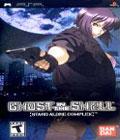Genre: Action
Publisher: Bandai
Developer: Bandai
Release Date: October 25, 2005
Buy 'GHOST IN THE SHELL': PSP
FPS. PSP. Works wonderfully.
These are words that, after Coded Arms, seemed improbable. These are words that, when the PSP hardware is considered (i.e., single analog "nub," sensitive, strangely spaced face buttons), seem even further off. But Ghost in the Shell: Standalone Complex works. Does it work as well as your usual console FPS? Is it a contender for the Halo throne? No. It is, however, a fun little game that, despite its heavy anime roots, is a game that console (read: not PC) FPS fans with a PSP in their back pockets should not be without.
The Ghost in the Shell universe is ripe for video game versions. That said, out of three tries, Standalone Complex for the PSP is the first to truly get it right. A strong (although conventional Japanese sci-fi) narrative runs between the game, introducing the characters well enough that even players without any previous knowledge of the series should be able to quickly grasp the who, what, where, and when of the story. This is a world of cyberpunk terrorism, which is matched up against the independent government-backed counter-op team, Section 9. As per the genre, the philosophical undertones of the increased blurriness of technology and humanity flow loosely under the narrative, but for the PSP telling, most of that is toned down for pure, cold military-techno-babble. Heroine Motoko Kusanagi is the most cold and straightforward of the bunch, a telling sign of the tone of the interactions.
In a brazen attempt at relieving viewers from Motoko's cold self is the addition of the Tamagotchi-meets-killing-machines, Tachikomas. These giant spider-like machines are supposedly ultra-intelligent self-learning AI entities, but really serve as a random variable, thanks to their immature (literally!) schoolgirl personalities. As per the story, missions fall to pieces thanks to these wild 'n crazy little runts, which seem to have no place in the delicate world of counter-terrorism, but, alas, this is an anime – one backed by Bandai, at that – and toys must be sold.
Each member of Section 9 is fully playable during almost every single mission, and each has different features which make him or her worth experimenting with individually (except Aremaki, the old-man leading force of Section 9, who is only playable in multiplayer games). Most of the characters are solid variations on the core weapon groups: handguns, sub-machine guns, and hand-explosives. However, Batou has access to a powerful Gatling gun, and Saito is a great sniper.
Between almost every mission is a lengthy cut scene which serves to sketch out the basic personalities of the characters as well as present a very personal take on the interactions between various military personnel, most of whom see Section 9 as an unnecessarily radical group. A detailed mission briefing follows, along with the meat of the game: character customization.
Players are usually able to choose from any member of Section 9 outside of Aremaki and outfit them with any of the weapons available to them. Playing through missions further unlocks weapons. In addition to this, the interesting Tachikoma customization system is actually extremely pertinent to the missions, finally giving more of a purpose to these annoying Transformer-meets-Pokemon wretches. (A light bulb goes off: These things were meant for video games the whole time, weren't they?) Up to four different Tachikomas can be readied for deployment at any time, although only a single one is allowed to be taken into battle. Each machine has six different customization points, each of which can be equipped with anything from a simple drill to a devastating Gatling gun, all depending on the mission at hand. Each Tachikoma has a different personality, so picking an aggressive one for a low-key mission might not be the best idea, for example.
Once in-game, the controls are still a bit to get used to, though it should be noted that this is about as good as FPS gaming will get on the PSP. The analog nub is reserved for moving forward and backwards as well as strafing, and oddly enough, the face buttons are stuck with controlling free-looking. This control setup seemed extremely backwards to me, as I tend to feel that analog movement is best given to free-looking, since minute adjustments are more commonly happening on that side of the controls, but it all makes sense once the down button is pressed on the d-pad for auto-locking.
Quite simply put, this game would be worthless in its final form without auto-locking. Free-look with the face buttons never ceases to be cumbersome, but when locked on to an enemy, most of the movement is left for strafing on the analog nub. Clearly, we aren't about to run into any Quake-level on-the-fly fine-tuning of motion, so the game has a lot less to do with skill than your everyday FPS, but the final result is one that works on the PSP. Think of Standalone Complex more in terms of Metroid Prime than Half-Life, and it all makes sense.
All in all, Standalone Complex as a PSP game is not the best FPS around, but at this point for portable gaming, it is on the top of the hill. While the DS seems like a much friendlier place for twitchy FPS action (which will hopefully be cemented by Metroid Prime: Hunters), the PSP's ability to produce high-end graphics and smooth framerates still leaves a healthy place for the genre on the system. While skill development is not required to enjoy Standalone Complex, the brainy customization options leave a lot of room for experimentation and, thus, lots of fun for those tired of the all-too simplistic action of Coded Arms.
If you've got an itchy trigger finger and a long plane ride coming up, Ghost in the Shell: Standalone Complex should undoubtedly be your next purchase.
Score: 8.2/10
More articles about Ghost in the Shell: Stand Alone Complex












 In the futuristic world of "Ghost in the Shell: Stand Alone Complex," crime knows no limits. Gamers can face off against cyber-criminals as members of Section 9, an elite group of secret intelligence operatives tasked to keep technological terrorists at bay. Players must use "Major" Motoko Kusanagi's agility, her partner Batou's strength, the rookie Togusa's stealth, or Saito's sniper skills to unravel the mysteries of Berutarube.
In the futuristic world of "Ghost in the Shell: Stand Alone Complex," crime knows no limits. Gamers can face off against cyber-criminals as members of Section 9, an elite group of secret intelligence operatives tasked to keep technological terrorists at bay. Players must use "Major" Motoko Kusanagi's agility, her partner Batou's strength, the rookie Togusa's stealth, or Saito's sniper skills to unravel the mysteries of Berutarube.



















